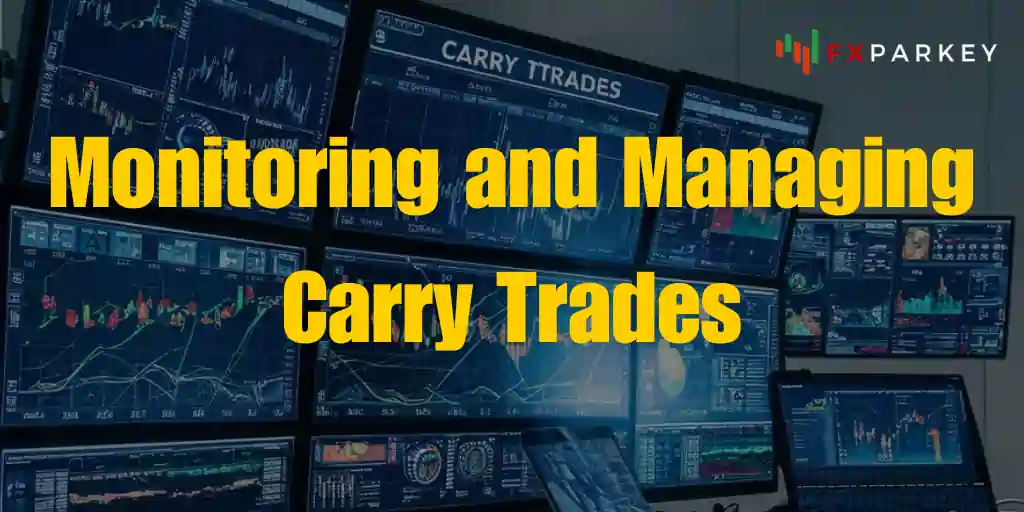As forex traders explore various strategies to maximize their profits, the carry trade strategy emerges as one of the more intriguing methods. This strategy leverages the difference in interest rates between two currencies to generate profit.
Imagine borrowing money in a country with low interest rates, like Japan, and investing it in a country with higher rates, such as Australia. The difference in interest rates becomes your profit! But beware, while the potential gains are enticing, the risks are equally significant, making a strategy best suited for those with a keen eye on market trends and central bank policies.
💹 What is Carry Trade in Forex?

In forex trading, carry trade is a strategy in which an investor borrows a currency with a low interest rate and uses the funds to purchase a different currency yielding a higher interest rate. The trader aims to profit from the difference between the two interest rates, also known as the interest rate differential.
Here's a simple example illustrating the basic concept :
| Action | Currency | Interest Rate |
|---|---|---|
| Borrow | Currency A | 1% |
| Invest | Currency B | 3% |
| Profit | – | 2% (3% – 1%) |
This strategy is particularly popular among long-term traders or investors who are not as concerned with short-term market fluctuations. Compared to other forex trading strategies like scalping, day trading, or swing trading, it involves holding positions for extended periods to earn interest over time.
How Carry Trade Works in Forex Markets
The fundamental premise of carry trade is to take advantage of the interest rate differential between two currencies. The trader begins by borrowing a currency with a lower interest rate and then buying a currency with a higher interest rate. The difference in interest rates is where the potential profit lies.
When the interest rate of the borrowed currency (Currency A) is lower than the interest rate of the purchased currency (Currency B), the trader earns interest. This is because while they pay interest on the borrowed currency, they also earn interest on the currency they hold.
It's important to note that forex carry trading is not without its risks. Market volatility and changes in interest rates can influence the profitability of the strategy. Furthermore, since positions are often leveraged, the potential for losses is amplified if the trade doesn't go as planned.
In the world of forex trading, understanding the nuances of different strategies is key to finding one that suits your trading style and risk tolerance. Whether it's trend trading, range trading, breakout trading, or carry trade, each strategy offers unique opportunities and challenges.
💹 Factors Influencing Carry Trade

The effectiveness of a carry trade strategy is influenced by a variety of factors. Forex traders need to understand these elements as they can significantly impact the potential profits and risks associated with carry trades.
Interest Rate Differentials
The differential in interest rates between two currencies is a vital factor in carry trade. Traders look to exploit this differential by borrowing in a currency with lower interest rates and investing in a currency with higher interest rates. The greater the differential, the higher the potential profit from the carry trade.
For example, if the interest rate in the US is 1% and in Australia it's 5%, a trader can borrow in US dollars, convert it into Australian dollars, and invest it at a higher rate. The interest rate differential in this case is 4% (5% – 1%).
Market Sentiment and Risk Appetite
Market sentiment and traders' risk appetite can significantly influence the success of a carry trade. During periods of market stability and bullish sentiment, riskier currencies with higher interest rates often appreciate, increasing the profit potential for carry trades. However, in turbulent market conditions or periods of bearish sentiment, traders may retreat to safe-haven currencies with lower interest rates, reducing the profitability of carry trades.
For instance, if the market sentiment is positive, traders might be more willing to take on more risk, making it more attractive. Conversely, in a negative market sentiment, traders might prefer safer strategies such as swing trading or position trading, thereby making carry trades less appealing.
Currency Volatility
Currency volatility is another key factor that can impact carry trades. Currencies with high volatility can offer higher interest rates and potentially greater profits. However, they also carry a higher risk as the exchange rate can fluctuate wildly, potentially wiping out any gains made from the interest rate differential.
For example, a currency with high volatility might offer an interest rate of 7%, while a currency with low volatility might offer an interest rate of 2%. While the potential profit is higher with the volatile currency, so is the risk.
In summary, successful carry trading involves a careful analysis of interest rate differentials, market sentiment, and currency volatility. By understanding these factors, forex traders can better anticipate potential profits and risks, and adjust their trade strategies accordingly.
Pros and Cons of Carry Trade
Like any trading strategy, carry trade in the Forex market comes with its own set of advantages and challenges. Understanding these aspects is crucial for any trader considering this approach.
| Pros | Cons |
|---|---|
| Potential for high returns: It can provide high returns, especially in low-interest-rate environments. | Currency risk: Carry trades are exposed to currency risk, where fluctuations in exchange rates can result in significant losses. |
| Diversification: Carry trades can be used to diversify a trader's portfolio by investing in different currencies from different countries. | Interest rate risk: Changes in interest rates can affect the profitability of carry trades. |
| Flexibility: It can be used in both short-term and long-term trading. | Liquidity risk: It may be difficult to exit quickly, especially in illiquid markets. |
| Passive income: Positive carry trades can generate passive income through interest rate differentials. |
Risks and Challenges Involved
However, carry trade is not without its challenges. The primary risk associated with this strategy lies in exchange rate fluctuations. If the borrowed currency appreciates against the bought currency, the trader could face significant losses.
Another risk is the potential for sudden changes in interest rates. Central banks can adjust interest rates, drastically affecting the profitability of carry trades. If the interest rate of the borrowed currency rises or the interest rate of the bought currency falls, the interest differential could shrink or even reverse.
Finally, trade can be affected by changes in market sentiment. In periods of high market volatility or risk aversion, carry trades can quickly become unprofitable as investors flock to safe-haven currencies.
Implementing Carry Trade Strategy
The success of a trade strategy lies in its correct implementation. This involves identifying suitable currency pairs, calculating potential profits and risks, and setting stop loss and take profit levels.
Identifying Suitable Currency Pairs
The first step in implementing a trading strategy is identifying suitable currency pairs. Carry trades involve buying a high-yielding currency and selling a low-yielding one, so traders should look for pairs where there is a significant interest rate differential.
Traders typically monitor economic calendars and central bank announcements to keep track of interest rate changes. They must also consider the stability and economic health of the countries associated with the currencies they choose.
Calculating Potential Profits and Risks
Once suitable currency pairs have been identified, the next step is to calculate potential profits and risks. The profit from a carry trade comes from the interest rate differential and any potential appreciation in the value of the high-yielding currency.
However, the trade is not without risks. These include the potential for the low-yielding currency to appreciate or for the high-yielding currency to depreciate. Traders must also consider the potential for changes in interest rates, which can affect the profitability of the trade.
Here's a basic table to help visualize the calculation:
| Currency Pair | Interest Rate Differential | Potential Profit | Potential Risk |
|---|---|---|---|
| High-yielding/Low-yielding | X% | X + appreciation of high-yielding currency | Depreciation of high-yielding currency or appreciation of low-yielding currency |
Setting Stop Loss and Take Profit Levels
After calculating potential profits and risks, it's crucial to set stop loss and take profit levels. These levels help manage risk and protect profits.
A stop loss is set at a level that will close the trade if the market moves against it, limiting losses. A take profit level is set at a point where the trade will close if the market moves favorably, securing profits.
The levels depend on the trader's risk tolerance and market volatility. As with any trading strategy, it's crucial to practice sound risk management techniques, like not risking more than a small percentage of the trading account on any single trade.
Monitoring and Managing Carry Trades

Proper management and monitoring are crucial to the success of any carry trade strategy. It requires regular checking of positions, adjusting strategies based on market conditions, and employing effective risk management techniques.
Regular Monitoring of Positions
In carry trade, like in any other investment strategy, regular monitoring of positions is vital. It helps a trader keep track of the interest rate differentials, currency price movements, and overall profitability of the trades. Staying updated with global financial news and economic calendars can give traders an edge in understanding market trends and making informed decisions.
Adjusting Strategies Based on Market Conditions
Market conditions can change rapidly, and these changes can have significant impacts on the profitability of carry trades. Traders need to be flexible and adapt their strategies in line with these changes.
For instance, if a trader observes that the currency pair they are targeting is showing increased volatility, they might need to adjust their position size or leverage to control risks. Similarly, changes in the interest rate differentials could signal the need for adjustments in the trade.
Traders might also need to switch to different trading strategies when trade is not yielding the desired results. For example, they could consider strategies like swing trading, day trading, position trading, scalping, trend trading, range trading, breakout trading, counter-trend trading, or news trading.
Risk Management Techniques
Implementing effective risk management techniques is a crucial part of any carry trade strategy. This includes setting appropriate stop loss and taking profit levels to protect against sudden market reversals.
Traders should also consider diversifying their portfolio by engaging in carry with different currency pairs. Diversification helps to spread the risk and minimize potential losses.
Another important risk management technique is to limit the use of leverage. While leverage can amplify profits, it can also increase losses. Therefore, it's important to use leverage judiciously and in line with one's risk tolerance.
Success Stories and Considerations

In the realm of Forex trading, carry trades have been a strategic choice for many successful traders. By understanding the success stories and considering the crucial factors, one can design a profitable trade strategy.
Case Studies of Successful Carry Trade Strategies
To illustrate the potential of carry trades, consider the case of a trader who took advantage of the interest rate differentials between the Japanese Yen (JPY) and the Australian Dollar (AUD) in 2006. The interest rate in Japan was 0.5%, while in Australia it was 7.5%. The trader borrowed JPY, converted it to AUD, and invested in an Australian bond that yielded 7.5%. The interest rate differential of 7% (7.5% – 0.5%) represents the profit from this trade, assuming no currency fluctuations.
| JPY | AUD | |
|---|---|---|
| Interest Rate | 0.5% | 7.5% |
| Profit (Interest Rate Differential) | 7% |
In another example, during the time of the Swiss Franc (CHF) carry trade in 2009, traders borrowed in low-interest-rate CHF and invested in higher-yielding currencies such as the New Zealand Dollar (NZD). The interest rate differential was approximately 6.25%. Again, this profit assumes no currency fluctuations.
| CHF | NZD | |
|---|---|---|
| Interest Rate | 0.75% | 7% |
| Profit (Interest Rate Differential) | 6.25% |
Important Considerations for Carry Trade Success
While carry trades can be profitable, they also come with risks that should be carefully considered. Here are some key points to keep in mind:
When implemented correctly, embracing a carry trade can be a profitable strategy. However, it's crucial to consider the potential risks and market conditions before entering a carry trade. With careful planning and risk management, carry trade can be a valuable addition to a Forex trader's toolkit.
Common Queries Related to Carry Trade
What is a Carry Trade?
A carry trade involves borrowing in a low-interest-rate currency and investing in a high-interest-rate currency to profit from the interest rate differential.
How does a Carry Trade work?
Investors borrow funds in a currency with low interest rates and convert them into a currency with higher interest rates, earning the difference.
What are the Risks associated with Carry Trades?
Key risks include exchange rate fluctuations, interest rate changes, and potential economic instability in the involved countries.
Why do investors engage in Carry Trades?
Investors seek to profit from the interest rate differential between two currencies, potentially earning higher returns than in their domestic markets.
Which Currencies are commonly used in Carry Trades?
Commonly used currencies include the Japanese yen (low interest) and the Australian dollar or New Zealand dollar (high interest).
What is the impact of Carry Trades on Currency Markets?
Carry trades can lead to significant capital flows, affecting exchange rates and potentially causing currency appreciation or depreciation.
How do Interest Rate changes affect Carry Trades?
If the interest rate in the funding currency rises or the interest rate in the target currency falls, the profitability of the carry trade decreases.
Can Carry Trades influence global financial stability?
Large-scale carry trades can contribute to financial instability by creating asset bubbles and increasing volatility in currency markets.
What is the role of leverage in Carry Trades?
Leverage amplifies potential returns and risks in carry trades, allowing investors to control larger positions with a smaller amount of capital.
How can investors mitigate risks in Carry Traders?
Investors can use hedging strategies, such as options and futures, to protect against adverse currency movements and interest rate changes.
💭 Conclusion
The Carry Trade strategy offers an attractive way to potentially profit from global interest rate differentials. While it can be a profitable venture, it's essential to remember that it comes with its own set of risks, particularly currency fluctuations and economic instability.
As with any investment strategy, thorough research and a keen understanding of market dynamics are key. So, whether you're a seasoned investor or just dipping your toes into the world of forex, keep your eyes open, stay informed, and you might just find that the carry trade adds a valuable dimension to your financial toolkit.






